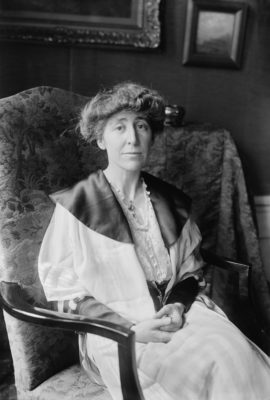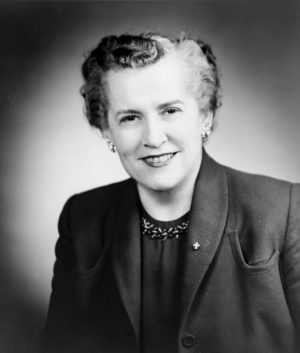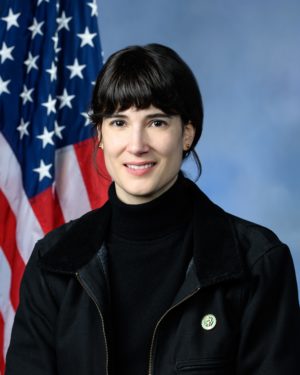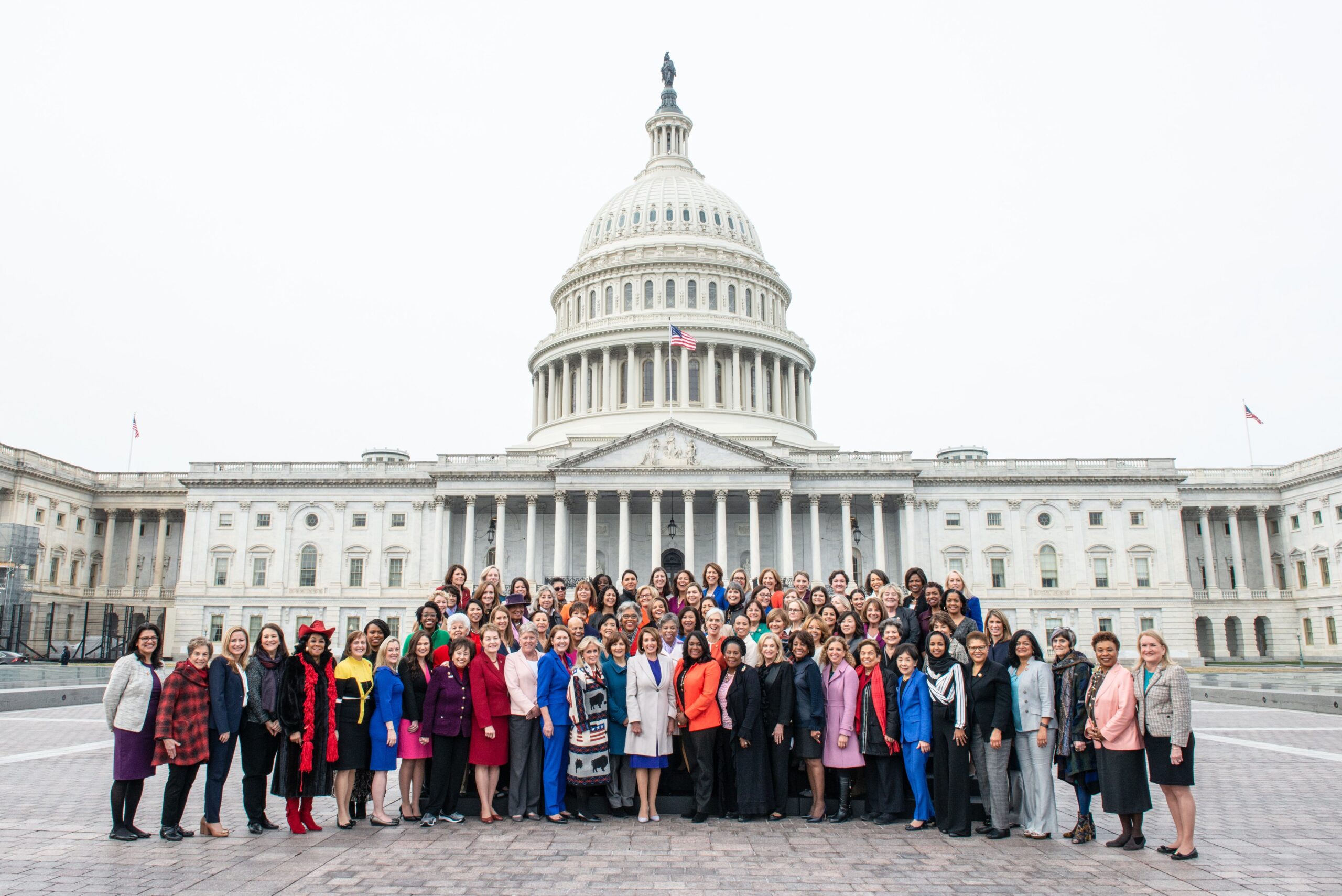Down a corridor in the U.S. Capitol, near the office of House Majority Whip, stands the statue of a determined-looking woman bearing a sheaf of papers.
She was a pioneer in the corridors of power and advocate of peace.

United States Representative Jeanette Rankin of Montana was the first woman elected to federal office and the only member of Congress to vote against U.S. entry into both World Wars I and II.
She would live long enough to come to Seattle for a Vietnam War protest.
She was, naturally, a Northwesterner. Our corner of America has put more women in high office, and earlier, than anyplace else in the country.
Speaking of the corridors of power, Senator Patty Murray-D-Washington, former preschool teacher from Shoreline, is the newly minted chair of the Senate Appropriations Committee and President Pro Tempore of the U.S. Senate.
Mapping the history and rise of women in our region’s politics is a fascinating enterprise, full of very different backgrounds, beliefs, characters and contributions.
As this is written, Representative Pramila Jayapal of Seattle, is a panelist on a CNN Sunday talk show, in her role as chair of the one hundred member Congressional Progressive Caucus.
A colleague, Representative Suzan DelBene, has just finished a term chairing the center-left New Democrats, and has been given the coveted post as head of the Democratic Congressional Campaign Committee.
The far right has been represented by such folk as the late Representative Helen Chenoweth, R‑Idaho, who suggested we pay for national parks by allowing hunting, and could not understand why fish runs were considered endangered when she could by canned salmon in any supermarket.
Two-term Representative Linda Smith, R‑Washington, came out of Phyllis Schlafly’s Eagle Forum, and lost to Murray in the state’s first Senate contest to feature a square-off between two women, in the 1998 midterms.
As long ago as 1962, the region was represented in the House four women of very different temperament.
Representative Edith Green, D‑Oregon, a prickly former schoolteacher, championed federal aid to education and headed state presidential campaigns of John and Robert Kennedy.
Representative Gracie Pfost, D‑Idaho, was nicknamed “Hell’s Belle” for championing a (never built) high dam in Hells Canyon on the Snake River.
Two “gentle ladies” from Washington, Democratic Representative Julia Butler Hansen and Republican Catherine May, joined across party lines as early advocates of prohibition against sex-based discrimination.
Hansen would become chair of the Interior subcommittee of the House Appropriations Committee, and boss of federal spending on public lands. She was buddies with House Speaker Carl Albert, another source of power.
Why the Northwest? We’re a region settled largely by people who left behind ingrown traditions from elsewhere. Seniority-centered political machines have never flourished in the Fourth Corner. Hence, there were no patronage barriers, and wait-your-turn arguments did not resonate. Murray was elected to the U.S. Senate after less than a term in the Washington State Senate.
There were only seventeen women in the U.S. House of Representatives when Oregon voters sent Edith Green there in 1954.
Today, there are one hundred and twenty-four women, primarily Democrats.
Service in a man’s Congress sometimes required stubbornness.

Women had to fight for access to the Senate’s members-only swimming pool and gym and to get their own workout room. The guys had enjoyed splashing around in their birthday suits.
On the policy side, Edith Green tried to include gender non-discrimination language in the 1964 Civil Rights Act. She was laughed at, but had the last laugh eight years later with passage of the Equal Pay Act and Title IX, which opened college athletics to women. Courage was required when Representative Jolene Unsoeld, D‑Washington, representing timber towns of Southwest Washington, refused to demagogue against courts’ decisions on preserving old growth forests. She rightly blamed log exports for plundering forests.
Patty Murray’s initial cause in Congress was getting more federal research money for diseases that impact women, her first Senate floor speech talking about ovarian cancer and friends who had died from it.
She was initial sponsor of the 1994 Violence Against Women Act and has fought for twenty-eight years to strengthen it.
The Senate now has twenty women senators, who break bread together even though Senator Marsha Blackburn, R‑Tennessee, blabs to right-wing media what gets discussed. It was a lot lonelier when Patty Murray and Senators Diane Feinstein and Barbara Boxer, D‑California, were elected in 1992. Elderly Senator Strom Thurmond of South Carolina behaved inappropriately toward Murray in a Senators-only elevator, not recognizing that she was a colleague.
On the flip side, it’s women who nowadays demonstrate adult behavior and cross-the-aisles collegiality in today’s polarized Congress.
A classic example: Senators Maria Cantwell, D‑Washington, and Lisa Murkowski, R‑Alaska, who after the 2014 election found themselves the ranking Democrat and Republican chair of the Senate Energy and Natural Resources Committee.
The two “gentle ladies” opposed each other on opening the Arctic Refuge to oil drilling – Murkowski for, Cantwell against – but made common cause in successfully pushing for construction of new U.S. polar icebreakers.
They appeared together in Seattle not long ago, celebrating the designation of “national” status for the Nordic National Maritime Museum.
One more lingering obstacle, lack of money. Democrats took back the U.S. House of Representatives in 2006, but with much grumbling that Campaign Committee chair Representative Rahm Emanuel had few women on his “A” list of House challengers. Three months ago, Marie Gluesenkamp-Perez, D‑Washington, scored the nation’s biggest House upset without receiving a dime from the DCCC. The next cycle promises to be different with DelBene heading the DCCC.
The 2024 election will go down in “her-story” in the Northwest.
A Democrat, Tina Kotek, was elected Governor of Oregon, prevailing in a contest of three women to succeed another woman, Governor Kate Brown. Kotek is the third woman to serve as Oregon’s governor in the past thirty years. The state elected a record four women to the U.S. House of Representatives.

Two women, Gluesenkamp-Perez in Washington and Rep. Mary Peltosa, D‑Alaska, flipped House seats previously held by Republicans. The Evergreen State now has eight women in its twelve-person congressional delegation.
Pressed by Trump-endorsed opponents, Senators Murray in Washington and Murkowski in Alaska both won reelection.
Once, long ago, one of the few paths to public office for women was to succeed a deceased spouse or husband. Senator Maureen Neuberger, D‑Oregon was an example, in 1960 winning the seat held by her late husband Senator Richard Neuberger. (She won using a slogan, “Join the Maureen Corps.”)
As recently, Sen. Barbara Mikulski, D‑Maryland, became the first female senator elected with no spousal or family bond.
Jeanette Rankin made it into Congress on her own – she was a women’s suffrage advocate – but found the House a lonely home.
No more. How long will it be until a woman’s place is in that other house down Pennsylvania Avenue – the White House?

